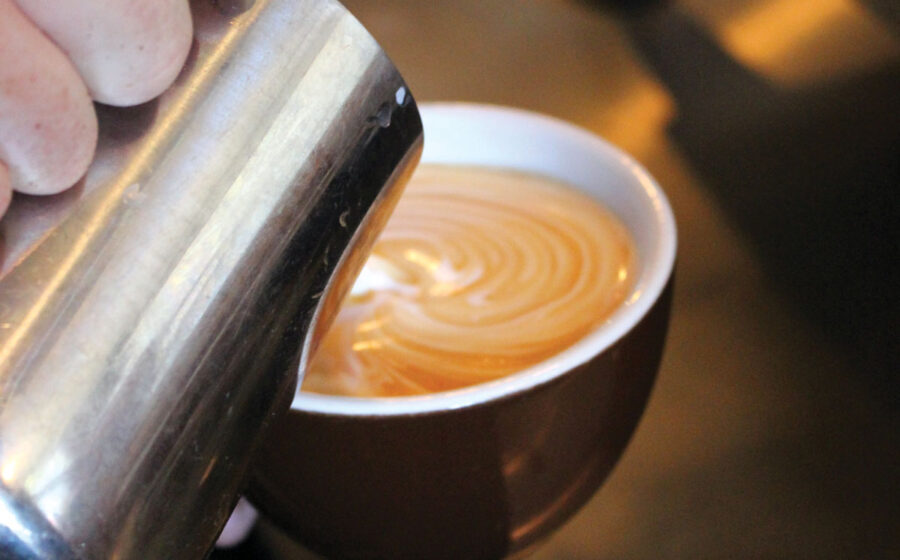[F]rom the outside, it looked like a great café. Mature trees stood guard on the sidewalk outside and provided shade for the tables and chairs that were occupied by customers chatting away or staring into the screens of phones and laptops. Plates were filled with baked goods and pastries, mugs and cups were filled with coffee. A classic scene.
I knew something was wrong, though, the moment I walked in the front door. A high-pitched scream pierced the air, coming from the vicinity of the espresso machine. Just as it became almost unbearable, the scream faded away, replaced by an angry roar. A few seconds later, the sounds stopped. The milk had been steamed. A hot, bubbly froth more air than liquid was poured without care into a mug of inky black espresso, and the words “cappuccino on the bar!” were shouted by the barista to no one in particular. The beverage sitting on the bar, waiting for the unlucky soul who ordered it, looked like the result of someone washing grubby hands in sudsy water, then pouring the results into a mug.
It wasn’t until I began working as a barista trainer myself that I began to realize how far off the mark my “excellent” beverages had been.
The barista, unfazed by the presentation, had moved on to his next drink. Without turning on the grinder, he filled his portafilter from the already full grinds chamber, immediately locked it into the grouphead, and then went about the business of prepping his milk for the next drink, which hadn’t been ordered yet.
Quietly, I sighed. “Looks like I’m getting black coffee,” I thought to myself. “That explains the lack of lattes on the patio.”
This scene, and hundreds of variations on it, plays out in coffee shops around the country on a daily basis. Baristas who know no better make bad-tasting drinks for customers who think they have no better options. These baristas, far from being malicious in their lack of care, simply haven’t been taught a better way, as they were most often trained by other baristas who also didn’t know what to do. In fact, in many cases, baristas in this situation genuinely believe that they are crafting fine beverages in the tradition of the thousands of people who came before them.
How do I know this? Because I was one of those baristas. For years, I took pride in serving drinks that I now look back on with a mix of shame and regret. I served cappuccinos that could be charitably called “abysmal.” I produced lattes with no foam made with espresso that had been ground dozens of minutes before I needed it. And every drink I served, I served with a smile, confident that the customer was going to love it, because I only offered the best.
It wasn’t until I began working as a barista trainer myself that I began to realize how far off the mark my “excellent” beverages had been. In researching the history and methods of espresso preparation, my eyes were opened to new and better ways to make drinks that actually looked and tasted good. Thus began my eight-year career in training baristas and coffee shop employees to do things differently. I devoted myself to constant learning and I sought out every expert I could talk to and every book I could read. I wasn’t going to be caught doing things poorly ever again.
When Portland Roasting Coffee hired me to be their coffee educator in 2010, I still had a lot to learn, but I knew that and I was open to it. What surprised me next was learning how many people simply didn’t realize that training their staff to do things excellently was even an option.
American coffee shop culture is still relatively young, having evolved into its modern form less than forty years ago, but we have learned so much in those few decades. The quality of equipment has gotten better, the knowledge of what’s chemically happening when we add water to coffee or apply steam to milk has deepened significantly, and the ability of coffee roasters or dedicated training centers to provide thorough, well-developed workshops and classes has grown exponentially.
So why do we still see old, outdated methods of beverage preparation and poorly made drinks?
Training. Or rather, a lack of it. Baristas should be trained in the latest and best processes for pulling shots of espresso, for steaming milk, and for working more efficiently (speed doesn’t have to come at the cost of quality!). After that, they should be encouraged to continue using those processes and held accountable when they don’t.
If you own a coffee shop, the best way to retain your current business and grow new business is to have friendly baristas who make excellent drinks consistently. The best way to get those baristas is to train them.
If you are a barista, the best way to grow as a coffee professional (and get better tips!) is to care enough about what you’re doing to pursue excellence in your work, whether it’s your customer service skills or your beverage creation acumen. The best way to improve those things is to ask for training.
Training is the path to excellence in coffee. Next month, we’ll start an espresso training program, beginning with treating the beans right.
—Nathanael May is Portland Roasting Coffee’s director of coffee and green coffee buyer.
















